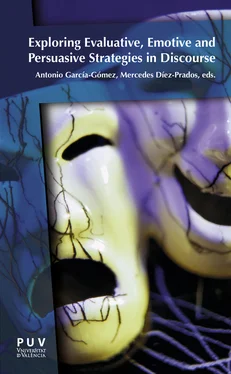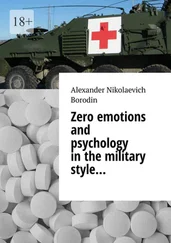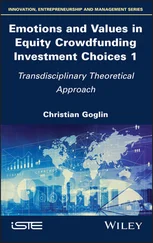(30)Éstas son algunas de las cuestiones que intentaré tratar en este libro. Pedir respuestas definitivas a preguntas tan fundamentales estaría fuera de lugar. (STrans_EXP_015)
The two subcategories of Disclaim, on the other hand, are more common in the Spanish texts than in the English texts. The difference in Deny is due to the fact that in Spanish the number of negative expressions is sometimes higher: in (31), coordination of two negative clauses is expressed by means of ni (‘nor’), while in English this coordination is often achieved by or , as may be seen in its translation (32):
(31)For the most part I will try not to advocate particular policies or to advance the agenda of the political left or right. (EO_EXP_020)
(32)En gran parte intentaré no defender unas políticas concretas ni promover la agenda de la derecha o la izquierda. (STrans_ EXP_020)
As for Counter, the larger number of occurrences in the Spanish texts uncovers the fact that the Spanish translations sometimes make this meaning explicit, for the sake of clarity, even if it is implicit in the originals. For example, the original fragment cited in (33) has no explicit Counter device; however, pero (‘but’) is included in the translation (34).
(33)The Earth is a place. It is by no means the only place. (EO_ EXP_002)
(34)La Tierra es un lugar, pero no es en absoluto el único lugar. (STrans_EXP_002)
6.3 COMPARISON OF THE ORIGINAL ENGLISH AND SPANISH TEXTS
The distribution of the main Engagement expressions in the original English and Spanish texts is specified in Tables 5and 6. Both
Table 5. Distribution of the Engagement spans by major categories in the original English and Spanish texts

Table 6. Distribution of the Engagement spans by delicate categories in the original English and Spanish texts
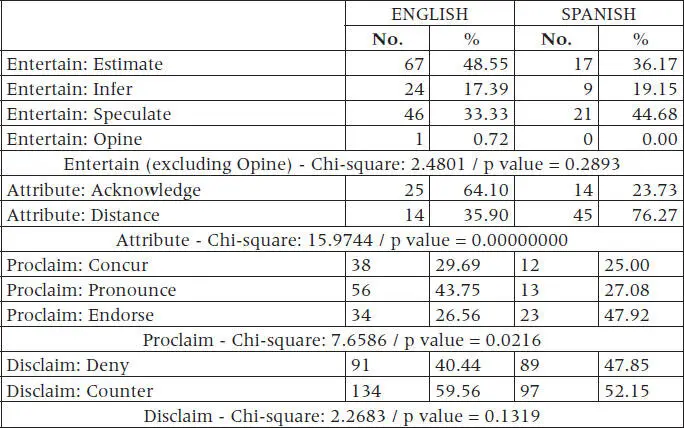
Expansion and Contraction are more common in the English texts but, as Table 5shows, there are no significant differences in the relative frequencies of the English and Spanish texts. On the other hand, the differences in the distribution of the subcategories of Expansion and Contraction are significant. As for the more delicate level of subcategories, Table 6shows that the distributional differences are significant for Attribute and Proclaim, but not for Entertain and Disclaim.
The expressions of Entertain in the English originals more than triple those of the Spanish originals. In spite of the non-significance in the distribution of the subtypes, it is worth mentioning that the English expressions of Estimate are almost four times as frequent as the Spanish ones. The English writers were thus more prone to express statements with a weak degree of probability: the most common expressions are the modal auxiliary may in its epistemic sense (9 occurrences), the adjective likely (7 times) and the adverb perhaps (6 times); other expressions, such as might or the noun risk also appear several times. In the Spanish texts, however, the adverb quizá/quizás (‘perhaps, maybe’) only appears twice. As for Infer, the expressions in the English texts more than double those in the Spanish texts. The verb seem occurs 5 times; curiously, its synonym appear occurs only once. In the Spanish texts, the close equivalent parecer does not occur at all.
In contrast to Entertain, Attribute is more common in the Spanish originals. Acknowledge is more frequent in the English texts, but the expressions of Distance in the Spanish texts more than triple those of the English texts; a reason for this may be that a large part of the Spanish expository texts concern history and contain citations of ancient sources of information such as Marco Polo, prestigious in their time but now unreliable because of modern knowledge (see example 19 above). In addition, and more importantly, the authors of the Spanish argumentative texts tend to cite more information from unreliable sources (and later refute it), as in (35), whose translation is quoted in (36):
(35)En la crisis financiera de 2008, la creencia de que los riesgos se pueden calcular, asegurar y vender a otros incitó a asumir más riesgos. (SO_ESS_001)
(36)In the financial crisis of 2008, the belief that risks could be calculated, insured and sold on to others incited dealers to take on even more risks. (ETrans_ESS_001)
Concerning Contraction, the number of expressions of Deny is virtually equal in the texts of the two languages, while Counter is more common in the English texts. If we consider that the cases of Counter are more frequent in all the Spanish texts than in all the English texts, we can infer the importance of the tendency of Spanish translations to use cohesive devices even if they are not used in the originals, pointed out in 6.2. and exemplified with (33) and (34) above. That is to say, this higher explicitness of adversative or concessive relations seems to be a feature of Spanish translations compared to the original English texts, but this feature is not seemingly due to a tendency of Spanish written discourse to signal these relationships more explicitly than English written discourse. Research on cohesion along these lines would be welcome.
6.4 COMPARISON OF THE ARGUMENTATIVE AND EXPOSITORY TEXTS
The distributional differences in the number of Expansion and Contraction devices in the argumentative and expository texts are yielded by the chi-square test as significant (see Table 7), the main difference being that Expansion is more frequent in the expository texts, while the expressions of Cited-expansion, although they are few altogether, are more than twice as common in the essays. That is to say, the essays display more cases of dialogic acknowledgement of alternative positions through reference to other sources. The percentages of Contraction are almost identical in the two subtypes. Noticeably, the relative percentages of Expansion and Contraction present in both essays and expository texts are similar to those registered for English and Spanish professional and consumer-generated film reviews in Carretero (2014: 77), which were 34.95 for Expansion and 65.05 for Contraction. These data together hint that, in non-fictional texts aiming at transmitting information and/ or persuading the reader, typically the occurrences of Contraction roughly double those of Expansion.
Table 7also shows that the distributional differences between the main categories of Expansion and Contraction are significant. In particular, Proclaim is markedly more frequent in the argumentative texts, while Entertain is more common in the expository texts, which is not surprising due to the greater need of the writers of essays to defend their dialogic position. The distribution of the most delicate subtypes, given in Table 8, indicates that the differences are significant for the subcategories of Contraction (Proclaim and Disclaim) but not for the subcategories of Expansion (Entertain and Attribute).
Table 7. Distribution of the Engagement spans by major categories in the argumentative and expository texts (originals and translations)
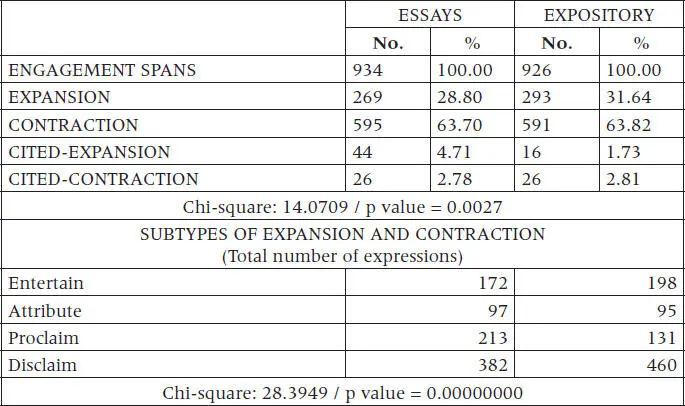
Table 8. Distribution of the Engagement spans by delicate categories in the argumentative and expository texts (originals and translations)
Читать дальше
